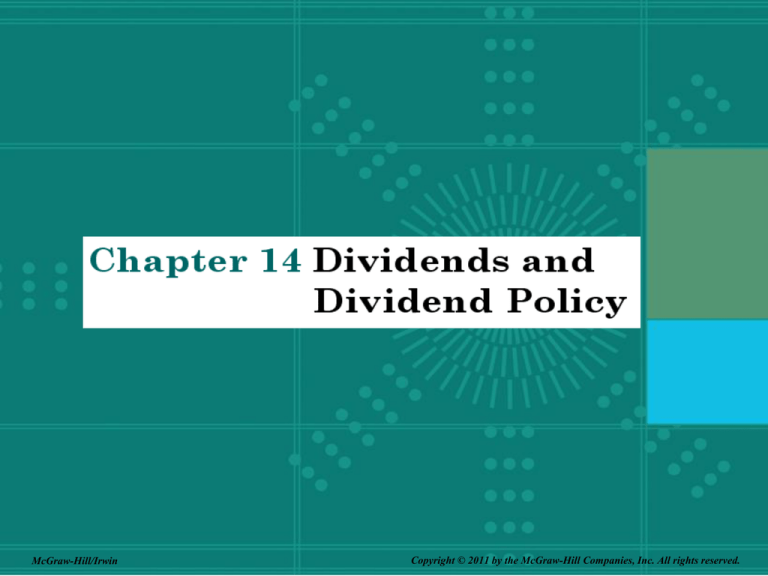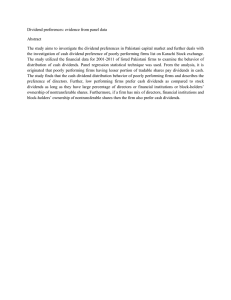
14-1
McGraw-Hill/Irwin
Copyright © 2011 by the McGraw-Hill Companies, Inc. All rights reserved.
Key Concepts and Skills
Understand:
– Dividend types and how they are paid
– The issues surrounding dividend policy
decisions
– The difference between cash and stock
dividends
– Why share repurchases are an alternative
to dividends
14-2
Chapter Outline
14.1
14.2
14.3
14.4
Cash Dividends and Dividend Payment
Does Dividend Policy Matter?
Establishing a Dividend Policy
Stock Repurchase: An Alternative to
Cash Dividends
14.5 Stock Dividends and Stock Splits
14-3
Cash Dividends
• Regular cash dividend = cash payments
made directly to stockholders, usually
each quarter
• Extra cash dividend = indication that the
“extra” amount may not be repeated in
the future
• Special cash dividend = similar to extra
dividend, but definitely won’t be
repeated
• Liquidating dividend = some or all of the
business has been sold
Return to
Quick Quiz
14-4
Dividend Payment Chronology
• Declaration Date – Board declares the
dividend and it becomes a liability of the firm
• Ex-dividend Date
– Occurs two business days before date of record
– If you buy stock on or after this date, you will not
receive the upcoming dividend
– Stock price generally drops by approximately the
amount of the dividend
• Date of Record – holders of record are
determined, and they will receive the
dividend payment
• Date of Payment – checks are mailed
Return to
Quick Quiz
14-5
The Ex-Dividend Day Price Drop
Figure 14.2
14-6
Does Dividend Policy Matter?
• Dividends matter
– The value of the stock is based on the
present value of expected future dividends
• Dividend policy may not matter
– Dividend policy is the decision to pay
dividends versus retaining funds to reinvest
in the firm
– In theory, if the firm reinvests capital now, it
will grow and can pay higher dividends in
the future
14-7
Illustration of Irrelevance
Wharton Corporation
•
•
•
•
•
All equity firm with 100 shares outstanding
Investors require a 10% return.
Expected cash flow = $10,000 each year
Plans to dissolve firm in 2 years
Firm can either:
A. Pay out dividends of $10,000 per year for each of
the next two years ($100 per share), or
B. Pay $11,000 this year, raising the other $1,000 by
issuing stock (or bonds), then pay an amount in
year 2 sufficient to provide new shareholders with
a 10% return
14-8
Illustration of Irrelevance
Wharton Corporation
PLAN A:
Year 1
Year 2
$10,000 $10,000
$0
$0
$10,000 $10,000
Cash Flow
New stock
CF available to S/H:
To New S/H:
Dividends
DPS
To Old S/H:
Dividends
DPS
Stock Price
E(R )
$
$0
$0
$0
$0
$10,000
$100
$10,000
$100
173.55
10%
PLAN B:
Year 1
Year 2
$10,000 $10,000
$1,000
$0
$11,000
$1,100
$110
$11,000
$110
$
$8,900
$89
173.55
10%
14-9
Factors Favoring a Low Payout
• Taxes:
– Individuals in upper income tax brackets might
prefer lower dividend payouts, with their immediate
tax consequences, in favor of higher capital gains
• Flotation costs:
– Low payouts can decrease the amount of capital
that needs to be raised, thereby lowering flotation
costs
• Dividend restrictions:
– Debt covenants may limit the percentage of
income that can be paid out as dividends
14-10
Factors Favoring a High Payout
• Desire for current income:
– Individuals in low tax brackets
– Groups that are prohibited from spending principal
(trusts and endowments)
• Uncertainty resolution:
– No guarantee that the higher future dividends will
materialize
• Taxes:
– Dividend exclusion for corporations
– Dividends versus capital gains irrelevant to taxexempt investors
14-11
Clientele Effects
• Investor preference:
– Some investors prefer low dividend payouts
– Some investors prefer high payouts
– Investors will buy stock in companies that
meet their dividend preferences
• What do you think will happen if a firm
changes its policy from a high payout to
a low payout? … or vice versa?
Return to
Quick Quiz
14-12
Stock Repurchase
• Company buys back shares of its own stock
– Open market = company buys its own stock in the
open market
– Tender offer = company states a purchase price
and a desired number of shares to be bought
– Targeted repurchase = firm repurchases shares
from specific individual shareholders
• Repurchase vs. cash dividend:
– Repurchase returns cash from the firm to the
stockholders
– Same as cash dividend in the absence of taxes
and transactions costs
Return to
Quick Quiz
14-13
Tax Effects of Stock Repurchases
• Cash dividends:
– No investor control over timing or size
– Taxed as ordinary income
• Repurchase:
– Allows investors to decide if they want a
current cash flow
– Taxed only if:
• They choose to sell AND
• They reap a capital gain on the sale
– Gain may qualify as lower taxed capital gains
if shares owned more than one year.
14-14
Dividend Summary
1. Aggregate dividend and stock repurchases are
massive and have increased steadily.
2. Dividends heavily concentrated among a small
number of large firms
3. Managers very reluctant to cut dividends
4. Managers smooth dividends, raising them
slowly as earnings grow.
5. Stock prices react to unanticipated changes in
dividends
14-15
Information Content of Dividends &
Repurchases
• Changes in the dividend signal management’s
view concerning the firm’s future prospects
• Stock repurchases signal that management
believes the current stock price is low
• Tender offers send a more positive signal than
open market repurchases because the
company is stating a specific stock price
• Stock prices often increase when repurchases
are announced
14-16
Pros and Cons of Paying Dividends
Pros
1.
2.
3.
4.
Cash dividends
underscore good
results and provide
support to stock price
Dividends may attract
institutional investors
Stock price usually
increases with a new
or increased dividend
Dividends absorb
excess cash and may
reduce agency costs
Cons
1.
Dividends are taxed to
recipients
Dividends can reduce
internal sources of
funding
2.
•
•
3.
May force firm to forgo
positive NPV projects
May require external
financing
Once established,
dividends cuts are
hard to make without
adversely affecting a
firm’s stock price.
14-17
Factors that Affect Dividend Decisions
Survey Results
Managers:
1. Try to avoid reducing dividends per share
2. Try to maintain a smooth dividend from
year to year
3. Consider the level of dividends per share
paid in recent quarters
4. Reluctant to make dividend changes that
might have to be reversed in the future
14-18
Stock Dividends
• Distribute additional shares of stock instead
of cash
• Increases the number of outstanding shares
• Small stock dividend
– Less than 20 to 25%
– If you own 100 shares and the company
declared a 10% stock dividend, you would
receive an additional 10 shares
• Large stock dividend – more than 20 to 25%
Return to
Quick Quiz
14-19
Stock Splits
• Essentially the same as a stock dividend
except expressed as a ratio
– For example, a 2-for-1 stock split is the
same as a 100% stock dividend
• Stock price is reduced when the stock
splits
• Common explanation for split is to return
price to a “more desirable trading range”
14-20
Reverse Stock Splits
•
Reverse Split reduces number of shares
outstanding
– For example, a 1-for-5 stock split replaces
every 5 shares of stock with one share
•
Reasons:
1.
2.
3.
4.
Transactions costs may be less for investors
Liquidity might be improved
Too low a price not considered “respectable”
Exchange minimum price per share
requirements
14-21
Quick Quiz
1. What are the different types of cash
dividends? (Slide 14.4)
2. How is a dividend paid? (Slide 14.5)
3. What is the clientele effect? (Slide 14.12)
4. What are stock dividends, and how do
they differ from cash dividends? (Slide 14.19)
5. How are share repurchases an alternative
to dividends, and why might investors
prefer them? (Slide 14.13)
14-22
Chapter 14
END








